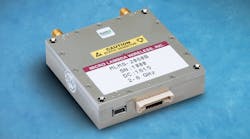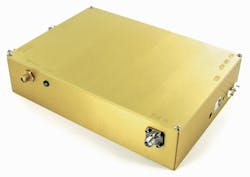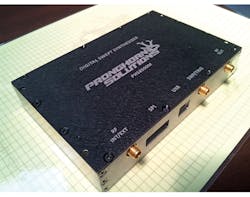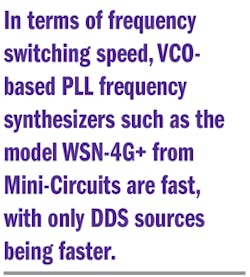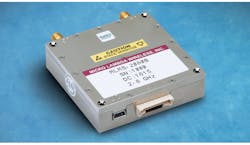Smaller Synthesizers Strive for Greater Stability
This file type includes high-resolution graphics and schematics when applicable.
Frequency synthesizers hold the key to dependable communications networks that so many users depend on each day. Whether as part of the network infrastructure equipment, in portable handheld products, or in test equipment to qualify their performance, RF/microwave frequency synthesizers come in many shapes and sizes and exploit multiple technologies. All are designed with a common goal regardless of package and technology: to generate stable frequencies with the lowest noise possible.
A number of parameters are used to qualify frequency synthesizers, with phase noise usually high on the list. But many other parameters help evaluate the quality of a synthesizer, often depending on the application—such as frequency range, switching speed, tuning resolution, and power consumption. Low phase noise enables high sensitivity when a synthesizer is employed as a local oscillator (LO) in a receiver, and stable transmit signals in a transmitter.
As wireless markets expanded and the number of communications networks and devices multiplied, synthesizer designers faced a trend common to many RF/microwave components—making their frequency sources smaller and more power-efficient. The industry has responded in recent years with products that pack some impressive performance levels into perpetually smaller housings.
Some of the tiniest frequency synthesizers are based on integrated-circuit (IC) semiconductor technology, which allows for integration of oscillators, phase-locked loops (PLLs), and other synthesizer components within a single chip. There is no best frequency synthesizer architecture, with various approaches based on analog and digital circuits such as phase-locked voltage-controlled oscillators (VCOs) and direct-digital-synthesizer (DDS) circuits, respectively. As with many high-frequency component technologies, each approach has its benefits and tradeoffs. For that reason, some synthesizer suppliers offer products based on a number of technologies.
1. Hereâs an example of a modular frequency synthesizer, for use from 8 to 20 GHz, in a metal case measuring 6.125 Ã 4.375 Ã 1.50 in. (Courtesy of Virginia Diodes)
Potpourri of Synthesizers
One such firm is Analog Devices, with its different types of PLL-based analog synthesizer ICs, as well as DDS sources based on conversion of digital inputs to analog outputs through a digital-to-analog converter (DAC). The company’s model ADF4350 is a wideband frequency synthesizer with integral VCO that can be used as a fractional-N or integer-N synthesizer to produce phase-locked output signals from 137.5 to 4400.0 MHz.
The ADF4350 operates on supplies of +3.0 to +3.6 V dc and exhibits typical phase noise of –110 dBc/Hz offset 100 kHz from the maximum output frequency of 4.4 GHz. Spurious levels stand at –70 dBc. The PLL synthesizer measures a mere 5 × 5 mm in a lead-frame chip-scale package (LFCSP).
For those who prefer a digital approach, the firm also offers the model AD9914, a DDS based on a 12-b DAC that operates at internal clock speeds to 3.5 Gsamples/s. It has five operating modes, including generation of single tones and programmable output modulation profiles. It operates on supplies of +1.8 and +3.3 V dc, and is housed in a 12- × 12-mm LFCSP. Phase noise is –128 dBc/Hz offset 1 kHz from a 1396-MHz carrier. Thanks to its digital architecture, this device provides precise control of output signals, with frequency resolution as fine as 190 pHz, 12-b amplitude scaling, and 16-b phase tuning resolution.
Another supplier of IC-based frequency synthesizers is Linear Technology, which was recently acquired by Analog Devices, essentially adding more strength to what was already a strong technology supplier. The acquisition was not by accident, as Linear Tech has established itself over the years as one of the leading suppliers of IC components, notably frequency synthesizers. Two recent product introductions—models LTC6946 and LTC6948—are integer-N and fractional-N PLL frequency synthesizers, respectively, with on-board VCOs. Both are capable of low-noise outputs past 6 GHz.
The fractional-N synthesizer employs a delta-sigma modulator with noise-shaping techniques to minimize fractional spurious noise. As with Analog Devices, the company has always been supportive of its synthesizer users and offers several free, easy-to-use software programs to simulate PLL synthesizer performance. The PLLWizard has been developed for use with integer-N PLL synthesizers such as the LTC6946, and the FracNWizard helps designers working with fractional-N PLLs like the LTC6948. Both programs are available for free download from the firm’s website.
This combination of PLL circuitry with on-board VCOs is also the basis for high-performance frequency synthesizers from Skyworks Solutions, including its model SKY73121-11. Rather than integrating components into a single IC, however, this frequency synthesizer uses a multichip-module (MCM) approach to combine a VCO, PLL, and switch within a compact housing.
The fractional-N synthesizer, which tunes from 1,805 to 1,890 MHz, is well-suited for cellular radio base-station transceivers, achieving typical phase noise of –126 dBc/Hz offset 200 kHz from the carrier. The signal source is supplied in a 38-pin MCM housing measuring 9 × 12 × 1.7 mm. It offers switching speed of typically 208 µs to settle to within ±2 kHz of a new frequency.
More Innovative Concepts
Synergy Microwave Corp., which offers extensive lines of PLL-based frequency synthesizers in coaxial and surface-mount packages, made news last year (see “Novel ASIC Helps Sources Silence Noise”) by unveiling a line of single- and dual-loop frequency synthesizers with outputs from 100 MHz to 15 GHz in SMT packages as small as 1.00 × 1.25 in.
The synthesizers feature a novel application-specific IC (ASIC) with PLL circuitry that allowed the use of several different oscillator types, including VCOs and dielectric resonator oscillators (DROs), as the synthesizer’s tunable source. As an example of the ASIC’s capabilities, a synthesizer with bandwidth of 2.2 to 2.7 GHz achieves phase noise as good as –118 dBc/Hz as close as 1 kHz from the carrier. The surface-mount synthesizer draws no more than 100 mA current from a +5-V dc supply.
In terms of frequency switching speed, VCO-based PLL frequency synthesizers such as the model WSN-4G+ from Mini-Circuits are fast, with only DDS sources being faster. The WSN-4G+ tunes from 700 to 4000 MHz with worst-case frequency tuning speed of 30 µs (and typically 15 µs in a surface-mount package measuring just 1.25 × 1.75 × 0.22 in.). Ideal for jammers, the source exhibits phase noise of typically –106 dBc/Hz offset 1 kHz from a 1-GHz carrier.
Virginia Diodes, a company perhaps best known for its millimeter-wave components, also offers modular frequency synthesizers that were dramatically reduced in size by re-engineering their power-supply circuitry (Fig. 1). In a housing measuring just 6.125 × 4.375 × 1.50 in., the synthesizer tunes from 8 to 20 GHz in 100-kHz steps and settles to within 20 Hz of the final frequency in less than 50 µs. It achieves phase noise of –100 dBc/Hz offset 10 kHz from the carrier and –115 dBc/Hz offset 100 kHz from the carrier. The source delivers healthy +16 dBm output with only –50 dBc spurious content and consumes 50 W power. It includes a Universal Serial Bus (USB) port for command and control.
A relative newcomer to frequency synthesizers, Pronghorn Solutions, headed by industry veteran Ganesh Basawapatna, offers sources based on both fractional-N PLL and integer-N PLL synthesizers. The model PHS8500 (Fig. 2) is an example of the latter, with low phase noise from 0.7 to 18.0 GHz (and options for lower and higher frequencies). It tunes with 0.01-Hz resolution and provides phase-continuous and phase-coherent switching speed of 100 µs in list mode. The company offers versions in benchtop, modular, and handheld configurations, with the modular unit measuring 3.5 × 5.5 × 1.0 in., weighing less than 1 lb., and consuming less than 8 W power.
3. A recent addition, this YIG-based frequency synthesizer is supplied as a single-slot PXI unit for test and system applications. (Courtesy of Micro Lambda Wireless Inc.)
As frequency synthesizers grow in size from tiny ICs, they tend to incorporate a greater amount of control circuitry, functioning more as self-contained subsystems or test instruments. The MLMS series of modular synthesizers from Micro Lambda Wireless, based on the company’s low-noise YIG oscillator technology, adds power and control circuitry to compact single-slot PXI modules (Fig. 3). The line includes standard models covering 2 to 8 GHz, 6 to 13 GHz, and 8 to 16 GHz. The synthesizers include a USB port for control from a personal computer (PC). They sacrifice VCO tuning speeds to deliver the excellent phase-noise characteristics of YIG sources.
The QuickSyn frequency synthesizers from National Instruments combine VCO/PLL-based architectures with DDS source generation to achieve frequency steps as fine as 0.001 Hz with low phase noise and 100-µs switching speeds. The company offers three configurations of the signal sources, including for millimeter-wave frequency coverage, with phase noise as good as –122 dBc/Hz offset 10 kHz from a 10-GHz carrier.
This article presents a small sample of the large number of RF/microwave frequency synthesizers currently on the market. Specifiers can start small, with ICs, and add their own control and power circuitry, or select larger synthesizers with more functionality included. Performance levels vary, but the general trend is to increase the functionality within smaller packages.
